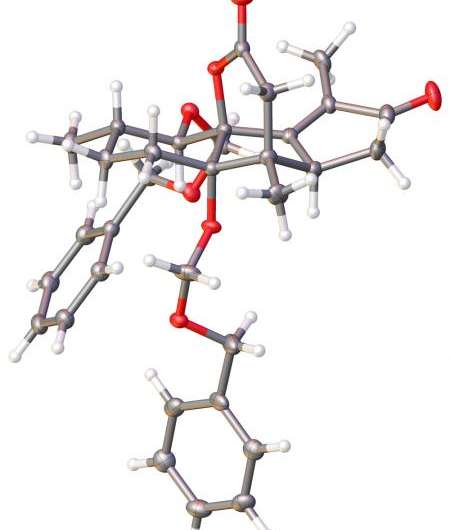August 26, 2016 report
New process halves the steps required to synthesize (+)-ryanodol

(Phys.org)—A trio of research chemists at California Institute of Technology has found a way to synthesize a type of ryanodol that requires approximately half the steps of the conventional process. In their paper published in the journal Science, team lead Sarah Reisman and colleagues Kangway Chuang and Chen Xu describe the process they developed and explain why it is important. Xavier Verdaguer with the Barcelona Institute of Science and Technology offers a Perspective piece on the work done by the team in the same issue and more fully outlines one of the techniques the team used, called the Pauson-Khand reaction.
To offer better medicine to people with various maladies, researchers look ever deeper into the intricate processes that take place in the human body—one of those involves signaling between cells, which is, of course, absolutely necessary for continued good health. Prior research has shown that molecules called ryanodol and a close cousin ryanodine are heavily involved in cell signaling—when things go wrong with associated structures, diseases like Alzheimer's can occur. For that reason, researchers would like to study the different types of ryanodol to learn more about how they work—and for that to happen, other researchers have to create it for them. Unfortunately, doing so using the conventional method has been laborious and expensive. Now, it appears that may change, as the researchers with this new effort have found a way to get the job done in far fewer steps.
To achieve this feat, the researchers tackled one of the more difficult problems associated with making ryanodol and ryanodine—the cage-like structures of their five interlocking rings. Instead of the multiple-step process others had used for altering them, the new technique involved using a Pauson-Khand reaction—a method that allows for turning strings of atoms into conjoined rings. The researchers also found that they could use selenium dioxide to add three oxygen molecules at one crucial juncture, elegantly streamlining the process.
While the new technique is impressive, the researchers readily acknowledge that it needs to be made more efficient if it is to be used commercially—currently, it stands at just 0.4 percent, which they note is rather normal for a new synthesis technique. They plan to continue with the work to improve efficiency and to add features such as fluorescence to allow for tracking the molecules in a living being.
More information: K. V. Chuang et al. A 15-step synthesis of (+)-ryanodol, Science (2016). DOI: 10.1126/science.aag1028
Abstract
(+)-Ryanodine and (+)-ryanodol are complex diterpenoids that modulate intracellular calcium-ion release at ryanodine receptors, ion channels critical for skeletal and cardiac muscle excitation-contraction coupling and synaptic transmission. Chemical derivatization of these diterpenoids has demonstrated that certain peripheral structural modifications can alter binding affinity and selectivity among ryanodine receptor isoforms. Here, we report a short chemical synthesis of (+)-ryanodol that proceeds in only 15 steps from the commercially available terpene (S)-pulegone. The efficiency of the synthesis derives from the use of a Pauson-Khand reaction to rapidly build the carbon framework and a SeO2-mediated oxidation to install three oxygen atoms in a single step. This work highlights how strategic C–O bond constructions can streamline the synthesis of polyhydroxylated terpenes by minimizing protecting group and redox adjustments.
Journal information: Science
© 2016 Phys.org




















